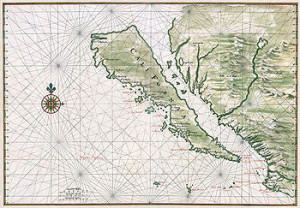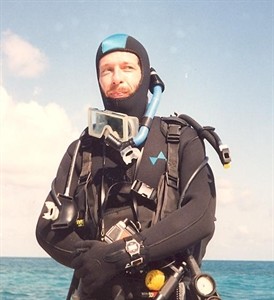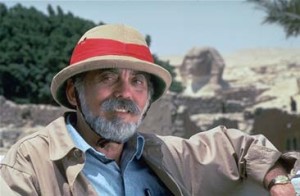Atlantis Rising
Caroli, Kenneth
Kenneth Caroli is a researcher from Florida and a regular contributor to Ancient American and Atlantis Rising magazines as well as The New Archaeology Review. He has tackled subjects such as the age of the Bimini Wall (AA vol.1.4), the date of Atlantis’ destruction (AA vol.7.43) and speculates on the possibility of a Celtic Atlantis (NAR June 2006). In Frank Joseph’s book, Atlantis and 2012, a map drawn by Caroli was included, showing the Azores as Atlantis and Lemuria as a number of islands in the South Pacific(a).
(a) Kenneth Caroli – Atlantisforschung.de (atlantisforschung-de.translate.goog)
Cartography
Cartography is defined by The International Cartographic Association “as the discipline dealing with the conception, production, dissemination and study of maps.” The earliest land maps can be traced back to Babylonia around 1400 BC. In 2017, Evangelos Livieratos, Professor Emeritus of the Aristotelian University of Thessaloniki Cartography Department, offered evidence that the ancient Greeks were the first to develop a primitive GPS system, using the stars and their relationship with the earth’s surface(g).
O.A.W. Dilkie (1915-1993) was an English classical scholar and the author of a well-regarded paper Greek and Roman Maps [1753]. The BBC offered an overview of the development of cartography since the 15th century(k).
The subject entered the Atlantis arena in 1665 with the publication of a speculative map(a) of Atlantis, situated in the Atlantic, by Athanasius Kircher. It was allegedly based on earlier Egyptian maps, but unfortunately, there has been no corroborative evidence to support this contention. Kircher’s map had been used to bolster a variety of location theories – Azores, Russia, Baffin Bay and Greenland, Kircher himself favoured the Azores.
Hy-Brasil was reputed to be an island to the west of Ireland and frequently associated with the story of Atlantis. The Genoese cartographer, Angellino de Dalorto (fl.1339), placed Hy-Brasil on a map as early as 1325. It is further claimed that Dalorto, sometimes known as Angelino Dulcert, also depicted Australia on his 1339 portolan chart(l).
However, on some 15th-century maps, the islands of the Azores appear as Isola de Brazil, or Insulla de Brazil. Apparently, it was not until as late as 1865 that Hy-Brasil was finally removed from official naval charts.
Another feature on ancient that can confuse is the placing of the south at the top of old charts, two examples of which are Kircher’s map of Atlantis and Al-Idrisi’s Tabula Rogeriana. Caroline Williams has an interesting article(e) on the BBC website relating to the history of map orientation.
 The unreliability of early maps is highlighted by the manner in which California has been depicted. In the 16th century, the maps of both Mercator and Ortelius correctly show Baja California as a peninsula, but in the following 17th and 18th centuries, it became an island on many charts despite written evidence to the contrary. There is a website dedicated to a study of the ‘island of California’(I), which incongruously ends with a brief reference to Atlantis, placing it in the Atlantic in the Region of Bermuda.
The unreliability of early maps is highlighted by the manner in which California has been depicted. In the 16th century, the maps of both Mercator and Ortelius correctly show Baja California as a peninsula, but in the following 17th and 18th centuries, it became an island on many charts despite written evidence to the contrary. There is a website dedicated to a study of the ‘island of California’(I), which incongruously ends with a brief reference to Atlantis, placing it in the Atlantic in the Region of Bermuda.
Donald S. Johnson in his well-illustrated Phantom Islands of the Atlantic[0652] discusses in detail the history of seven legendary islands. This fascinating book offers every reason to treat the details of early cartography with extreme caution.
Further difficulties with old cartography are the result of early mapmakers having a dread of blank spaces, a view outlined in a recent (Nov. 2017) National Geographic online article(h).
The most widely referred to map in relation to Atlantis as well as advanced ancient civilisations is the Piri Reis chart. This arguably depicts an ice-free Antarctica and has been used to develop the idea that Atlantis had been located there and was destroyed when a sudden pole shift caused the southern icecap to move to its present position. Rose and Rand Flem-Ath are the leading proponents of this idea based on the findings of Charles Hapgood. Other maps such as that of Phillipe Buache, the renowned French geographer, published in 1737, are claimed to show an ice-free Antarctica.
It is claimed by Ivan Petricevic that The Ben Zara Map of 1487 “displays remnants of glaciers in Britain, but also extremely detailed depictions of islands in the Mediterranean and Aegean seas. Today, these islands still exist, but due to rising water levels, these are now underwater.”(j)
Dale Drinnon had an interesting if speculative, article on ancient maps and their possible relevance to the story of Atlantis(b). Another article in Atlantis Rising magazine (July/August 2014) argues that the quality of medieval navigational charts (portolans) of the Mediterranean exceeded the capabilities of the instruments and knowledge in the region at that time and must have originated elsewhere. However, Roel Nicolai at Holland’s Utrecht University, who expressed these sentiments, was unwilling to nominate Atlantis as the source of the maps(c).
When asked in a recent interview what he meant by ‘advanced civilisation Graham Hancock revealed(u) that “I think we’re talking about a civilization – more than 12,000 years ago – which was as advanced as our civilization was, say in the late 18th century or early 19th century. In other words, they could navigate the world, they could explore the world, they could measure the world accurately, they had precise astronomy, they could create beautiful maps that were accurate in terms of latitude and longitude. That kind of level of civilization.”
Enrique García Barthe is an Argentinian cartographer who has an interesting Spanish/English website(d) dealing with pre-Columbian maps. Although many people have heard of the Piri Reis Map and the controversy surrounding it, García Barthe introduces a lot of new maps that appear to complement Piri Reis.
In 2015, Melissa Brooks used the data in the Atlantipedia chronology of location theories to develop a map(f) showing the distribution and level of support for the various theories on offer.
(a) https://www.thenakedscientists.com/forum/index.php?topic=19800.100
(b) See: Archive 3591
(d) https://web.archive.org/web/20111026020513/https://globalizacion.no.sapo.pt/ingles/pon_ing_1.htm
(e) https://www.bbc.com/future/story/20160614-maps-have-north-at-the-top-but-it-couldve-been-different
(f) https://www.guerrillacartography.org/?s=Atlantis
(h) Why Ancient Mapmakers Were Terrified of Blank Spaces (archive.org) *
(i) https://californiaasanisland.org/
(j) 9 Extremely Ancient Maps That Should Not Exist | Ancient Code (archive.org)
(k) https://www.bbc.com/travel/story/20180819-the-travel-guides-that-charted-our-world
(l) https://www.dailygrail.com/2015/01/ancient-maps-reveal-a-thread-of-truth-weaved-through-antiquity/
(m) https://www.dailygrail.com/2019/04/watch-graham-hancock-discuss-his-new-book-america-before/
Schoch, Robert M.
Robert M. Schoch is a Yale scholar, geologist and paleontologist. At the invitation of John Anthony West, he agreed to inspect  the Sphinx and offer an opinion on the nature of the erosion to be seen on it. He found that the cause of this erosion was precipitation rather than windblown sand. As Egypt has had an arid climate for many thousands of years, Dr Schoch reached the conclusion that at least the front of the Sphinx had been carved between 7000 and 5000 BC, when the climate had been considerably wetter.
the Sphinx and offer an opinion on the nature of the erosion to be seen on it. He found that the cause of this erosion was precipitation rather than windblown sand. As Egypt has had an arid climate for many thousands of years, Dr Schoch reached the conclusion that at least the front of the Sphinx had been carved between 7000 and 5000 BC, when the climate had been considerably wetter.
In the same book, Voices of the Rocks [454], he endorsed (p.123) the conclusions of Mary Settegast [545] who claimed that Plato’s Atlantis story was a reference to the Magdalenian culture that inhabited the coastal regions of the Western Mediterranean during the 9th millennium BC. Schoch devotes a chapter to the subject of Atlantis and interestingly lists a number of sites to which the Greeks applied the appellation ‘Pillars of Heracles‘ apart from the Strait of Gibraltar.
“The Greeks, however, used the name Pillars of Herakles to mark other sites besides Gibraltar, some outside the Mediterranean – namely, the Canary Islands in the Atlantic and the Strait of Kerch dividing the Black Sea from the Sea of Azov – and even more inside – specifically, the Strait of Bonifacio between Corsica and Sardinia, the Strait of Messina between mainland Italy and Sicily, the Greek Peloponnese, the mountainous coast of Tunisia, and the Nile Delta.” [p.87] A highly critical review of Schoch’s ‘Voices’ can be read online(n).
In his Voyages of the Pyramid Builders [455], he reiterates his conviction “that Plato’s story is, at least in part, a fictionalized account of a great Mediterranean war at a time of intense climatic change between the tenth and eighth millennia BC.” A critique by William P Eigles tackles ‘Voyages’ in Atlantis Rising magazine # 37, where Schoch endeavours to link the global presence of pyramids as a possible expression of hyperdiffusion. Eigles comments that Schoch “may simply be trying to prove too much here. Many of the motivations, reasons and interpretations he offers for the various activities and actions on the part of the ancients are clearly speculative in nature.(ad)”
This 1990 declaration regarding the Sphinx generated an international reputation for Schoch. Such a controversial conclusion was obviously greeted warmly by the supporters of the 9,000-year-old date for Atlantis allegedly given by the Egyptian priests to Solon. This accidental intervention by Schoch in the debate regarding the dating of Atlantis has unfortunately done nothing to resolve the issue. Fierce debate continues regarding the date of the Sphinx. However, there appears to be a gradual acceptance of Schoch’s views by other professional geologists such as David Coxhill. Another geologist, Colin Reader, while not accepting all of Schoch’s conclusions, believes that the Sphinx predates King Khufu, the father of Khafre, who has been traditionally accepted as the builder of the Sphinx, with the monument bearing his image(v)(w)(x).
Schoch subsequently pushed the date of the Sphinx as far back as circa 10,000 BCE and he now suggests that the monument was carved in the shape of a lioness.(ae)
>>It appears that Schoch’s experiences regarding the Sphinx have whetted his appetite for prehistorical controversies and then wrote two further books, again with R.A. McNally, about the origins of the pyramid builders in Voyages of the Pyramid Builders[455] and Pyramid Quest [456], both of which were met with mixed reviews1. The authors “trace the many pyramid-building cultures back to what may be their ultimate source: Sundaland, a continent-sized stretch of land in Southeast Asia (located under the current southern reach of the South China Sea) that was inundated by rising sea levels after the end of the last ice age, a catastrophic event that may have been connected to cometary activity in the skies observed by the inhabitants of Sundaland.
As we argue in our book, pyramids are symbolically connected with comets, and the Sundalanders may well have originated the ancient pyramid tradition, then carried it with them as they fled the rising waters. Those who went northwest contributed to the cultural mélange that gave rise first to the pyramid cultures of Sumeria, Egypt, and Mesopotamia and later to those in India, Southeast Asia, and China. Sundalanders heading east may have gotten as far as Peru, where pyramids rose at Aspero at the end of the fourth millennium B.C. The American pyramid tradition died out until it was reinvigorated, from the twelfth century B.C. on, by Pacific Rim mariners, primarily Chinese. This contact contributed to the pyramid building of the Olmecs, which spread across Mesoamerica and later into the Andes.” (aj)<<
Unfortunately, he includes a reference to Ireland’s Newgrange as a form of ‘pyramid building’, an idea I reject, since it shares neither form nor function with the Egyptian pyramids. The goodreads.com website offers a very critical review of this book(a) as has the late Professor Garrett Fagan(ag).
Schoch and McNally have recently dared to enter into the highly charged debate regarding the dating of the Great Pyramid at Giza[456][457].
Schoch seems to be venturing further and further from his natural comfort zone of geology. In 2007, he wrote an article on Telepathy(d) and was later due to address the Electric Universe Conference in Las Vegas in 2012(c) and deliver a paper entitled The Catastrophic Termination of the Last Ice Age. In it, he will claim that around 10,000 BC the Earth underwent ‘dramatic catastrophic changes’ as a result of ‘our unstable Sun erupting at the end of the last Ice Age, melting the extensive glaciers and triggering climate warming. The full paper should be an interesting read. He continues to argue against the Younger Dryas Impact Hypothesis(r).
His retreat from conventional science may be now complete as he delves into the strange world of lycanthropy (the study of werewolves)(o).
Schoch’s work is now promoted through his own website(b), which includes a wide range of articles. On it, both he and his associate, Colette Dowell, have been very critical of the Bosnian pyramid claims of Semir Osmanagic following a visit there in 2006. However, in what appears to be an article(l) written in 2011 or 2012, Osmanagic responds with scathing criticism of Schoch’s work. His attack on Schoch was later added to by an assault from Jock Doubleday in a very lengthy article(y) in which, among other matters, he accuses Schoch of a series of thirteen lies! I should perhaps mention that Doubleday has been featured for some years now in the burgeoning Encyclopedia of American Loons(z). As well as that, elsewhere, a very personal attack has also been made on Collette Dowell(aa). Support for Schoch’s claim of a Bosnian pyramid hoax is also available(ab).
Schoch has now turned his attention to the emergence and demise of very early civilisations, before that of dynastic Egypt or Sumeria. When he combined his early date for the Sphinx with other discoveries such as that of Nabta Playa and Göbekli Tepe and Gunung Padang(m), he concluded that the origins of civilisation go back much further than generally accepted. He then looked at the bigger and perhaps more important question of the cause of their collapse. In a 2009 special edition (N0.8) of New Dawn magazine, he speculated on the possibility that the ending of such early civilisations was caused by the earth’s encounter with one or more asteroids or comets.
In his book(f), Forgotten Civilization[867], Schoch claims that coronal mass ejections (CMEs) from the sun around 9700 BC devastated our planet with electrical discharges, triggering seismic and volcanic activity as well as ending the Ice Age with its consequent floods. All this ‘eradicated the civilisation of the time and set humanity back thousands of years, only to re-emerge around 3500 BC with scattered memories and nascent abilities.’ In an article written(g) in March 2012, Schoch wrote about the ‘Carrington Event’ of 1859 which resulted from a massive solar event that year.
Schoch’s paper had the somewhat disturbing title of ‘Death Star’ and perhaps even more unsettling was the revelation in March 2019 that evidence of at least three major solar ‘proton attacks’ over the past 3,000 years. The suggestion is that these episodes are to be expected with some degree of regularity, which may create ever-increasing disruption as our dependency on electricity expands. The recent report(q) indicates that the most powerful event identified so far took place around 610 BC. Without a power grid to damage at the time, we are unaware of what effect it had on the people of that time and I would hope that a review of the literature of that era might reveal some corroboration.
A video clip from his recent Las Vegas lecture is now available on YouTube(h). His talk is based on an article(i) in the July-August 2010 edition of New Dawn magazine, which is now available online and will play a large part in his Forgotten Civilization. He highlights some fascinating similarities between the Rongorongo script of Easter Island, the Nasca petroglyphs and the plasma figures of Dr Anthony L. Peratt together with their possible association with the ending of the last Ice Age.
For me, the most disturbing aspect of Schoch’s book is his apocalyptic vision of global catastrophes that he anticipates may again turn the few survivors back into troglodytes!
“The revised and expanded edition of Forgotten Civilization, which bears a new subtitle, was released in March of 2021. It includes everything in the first edition plus a new final chapter and various updates to other chapters throughout the book. Thus, the new edition is approximately 150 pages longer, including over 40 new/additional photographs. As I detail in this revision, a number of new discoveries made since the first edition was published reinforce my contention that true civilization existed prior to the end of the last ice age, some 12,000 years ago, and that civilization was decimated by the solar outburst(s) that occurred then, throwing humanity into a Solar-Induced Dark Age for some 6,000 years before the reemergence of civilization around 4000–3000 BCE.”(ai)
However, Jason Colavito has reviewed Schoch’s claims relating to both the Rongorongo script(j) and Göbekli Tepe(k) and has found his ideas wanting. Colavito found further ammunition in the forthcoming book, Origins of the Sphinx[1374], which Schoch co-authored with Robert Bauval, describing it as ‘a virtual rewriting of’ Keeper of Genesis(p). In 2019, Schoch expanded further on his opinions regarding the importance of Göbekli Tepe with a claim that its builders possessed some level of literacy(s), provoking further criticism from Colavito(r). Schoch expanded on this claim in a subsequent post(ac), but for me, I find this proposed literacy at Göbekli Tepe a push too far.
One of the great mysteries of Göbekli Tepe is that it was deliberately reburied but fortunately for us, this left it in perfect condition for us to study. Schoch has suggested that this was done to protect it from damage by CME’s such as occurred around 9700 BC (see above). This sounds like closing the stable door after the horse has bolted. He then takes this idea further and proposes in a lengthy article that the Egyptians did something similar(ah), but uncovered them later for the pharaohs to develop. I’m not convinced.
ORACUL – The Organization for the Research of Ancient Cultures is a not-for-profit body, co-founded by Schoch “dedicated to the scientific study of civilization’s origins. It is our hope that through research advocacy, publishing, and educational outreach, further evidence for mankind’s remote and forgotten past will be uncovered.”(af)
(a) Greg’s review of Voyages of the Pyramid Builders (goodreads.com)
(c) https://www.thunderbolts.info/wp/
(f) https://www.amazon.co.uk/Forgotten-Civilization-Solar-Outbursts-Future/dp/1594774978
(g) https://dailygrail.com/Guest-Articles/2012/3/Death-Star
(h) https://www.youtube.com/watch?v=PUqdYBxbbck
(j) https://robertschoch.com/plasma_iceage.html
(n) https://anamericaninbosnia.blogspot.ie/2013/03/witchcraft-cartography-and-clairvoyant.html
(o) https://www.dailygrail.com/Guest-Articles/2016/10/The-Werewolf
(q) https://www.livescience.com/64964-huge-ancient-solar-storm-hit-earth.html
(t) New Dawn Magazine -July August 2010
(u) New Dawn Magazine- Special Issue No.8 2009)
(v) https://www.academia.edu/21651229/Giza_Before_The_Fourth_Dynasty
(w) (99+) (PDF) Khufu Knew the Sphinx | Colin Reader – Academia.edu
(y) An American in Bosnia: The Mysterious Anti-Scientific Agenda of Robert Schoch
(z) https://americanloons.blogspot.com/2015/12/1555-jock-doubleday.html
(ab) Heavy Futz: Don’t bother making a pligrimage to the “Bosnian Pyramids”
(ac) https://www.robertschoch.com/gobekli_tepe_writing.html
(ad) Atlantis Rising magazine #37 http://pdfarchive.info/index.php?pages/At
(ae) https://www.robertschoch.com/sphinx.html
(af) Robert M. Schoch: ORACUL (robertschoch.com)
(ag) https://www.hallofmaat.com/lostciv/review-of-voyages-of-the-pyramid-builders/
(ah) https://www.robertschoch.com/ancient_burial_of_egypt.html
(ai) https://www.robertschoch.com/publications.html
(aj) https://www.hnn.us/article/a-theory-about-pyramids-that-could-change-the-way- *
Kühne, Dr. Rainer Walter *
 Dr Rainer Walter Kühne was born in Braunschweig, Germany in 1970 and has a Ph.D. in Physics (Dortmund 2001). He has proposed a modification of Quantum Electrodynamics (QED), which predicts a second kind of photon (’magnetic photon’) and a second kind of light (’magnetic photon rays’). He has also offered evidence for the existence of a rotating universe. He lectured in the Institute of Physics at Dortmund University.
Dr Rainer Walter Kühne was born in Braunschweig, Germany in 1970 and has a Ph.D. in Physics (Dortmund 2001). He has proposed a modification of Quantum Electrodynamics (QED), which predicts a second kind of photon (’magnetic photon’) and a second kind of light (’magnetic photon rays’). He has also offered evidence for the existence of a rotating universe. He lectured in the Institute of Physics at Dortmund University.
Kühne had studied Plato’s Atlantis story and concluded that many of its elements are fictional although based on three historical but unconnected sources. For example, on the basis of Plato’s description of the Acropolis at the time of the ‘Atlantean’ war, it can be dated to around 1200 BC, not 9600 BC. He linked the Atlantean war with the invasion of the ‘Sea Peoples’ recorded by the Egyptians and locates Atlantis in Andalusia in Southern Spain and places its capital in the valley of the Guadalquivir, south of Seville. Satellite photos of this same area have recently revealed rectangular structures surrounded by parts of concentric circles with dimensions similar to Plato’s description of Atlantis. Werner Wickboldt, a teacher, who lives in Braunschweig (Kühne’s birthplace) announced the discovery of these features on January 8th, 2003. These structures include a rectangle of size 180 meters x 90 meters (Temple of Poseidon?) and a square of length 180 meters (Temple of Poseidon and Cleito?). Concentric circles surround these two rectangular structures so that the site closely resembles Plato’s description of the Atlantean capital. However, the dimensions of this location are approximately 20% larger than Plato’s figures, so Kühne has suggested that the unit of measurement used by Plato, the stade, may have been greater than usually accepted(i).
Kühne also proposes that Tartessos can be identified as the biblical Tarshish and is the model for Plato’s Atlantis(d).
It was a surprise to many when, in their June 2004 edition[429], the highly respected journal Antiquity published details of this discovery and Kühne’s interpretation(a).
To add a bit of spice to Kühne’s investigations, he, together with Jacques Collina-Girard, has been accused of plagiarism by Georgeos Diaz-Montexano(b).
Overall, despite offering a number of interesting thoughts regarding Plato’s Atlantis, we find Kühne sceptical regarding its actual existence, describing Plato’s account of it as a “philosophical fiction invented to describe Plato’s fictitious ideal state in the case of war.” Nevertheless, he is keen to point out that the narrative does contain historically factual elements.(e)
The excellent German site, atlantisforschung.de has described Kühne in the following terms(g), “Dr Kühne is one of the most distinguished representatives of university-scientifically oriented Atlantis research in Germany. Among other things, he discusses the possibility that Plato in his Atlantis story mixed an account of the Sea Peoples and Athens around 1200 BC with traditions about a Spanish city, which could have been the Iberian metropolis of Tartessos – probably destroyed in the 6th century BC by a Carthaginian expeditionary corps.”
The site also includes a link to an interesting paper by Kühne in which he lists the main references to Atlantis in the scientific literature(h).
An outline of Kühne’s theories, in English, is also available on the Internet(c).
In issue #46 of Atlantis Rising magazine Kühne published a letter outlining his experiences when he sought to present his diploma thesis and later his Ph.D. thesis including material that ran counter to that of his professor. In his words “To conclude, what can happen when a young researcher thinks he has an important theory? From my own experience, I learned that he will get difficulties with the acceptance of his diploma thesis. It will become impossible to start a Ph.D. thesis at the same university. His professor will decline to accept his dissertation. After completion of his Ph.D. thesis, he will be unemployed, although by then he has ten scientific publications, eight of them authored by him alone.”(f)
(a) https://antiquity.ac.uk/ProjGall/kuhne/ (if offline, see Archive 2081)
(b) eListas.net – Mis eListas: odiseo: Mensajes (archive.org) *
(c) Location and Dating of Atlantis (archive.org)
(d) https://vixra.org/pdf/1104.0035v1.pdf
(e) Did Ulysses Travel to Atlantis – https://vixra.org/pdf/1103.0058v1.pdf
(f) Atlantis Rising magazine #46 p6 At – PDF Archive
(g) Rainer W. Kühne – Atlantisforschung.de (German)
(h) Atlantis in the Scientific Literature – Atlantisforschung.de (German)
Archive 7057 | (atlantipedia.ie) (English)
Donato, William Michael
William Michael Donato is an American archaeologist who holds an MA in  anthropology and is a regular contributor to the Ancient American and Atlantis Rising magazines and is an advocate of a Bimini location for Atlantis. He was the founder of The Atlantis Organisation (TAO) whose work is now continued by the Apex Institute(a), which was established in 2001 to investigate sites in the Bahamas and other places around the world that might provide evidence of ancient advanced civilizations.
anthropology and is a regular contributor to the Ancient American and Atlantis Rising magazines and is an advocate of a Bimini location for Atlantis. He was the founder of The Atlantis Organisation (TAO) whose work is now continued by the Apex Institute(a), which was established in 2001 to investigate sites in the Bahamas and other places around the world that might provide evidence of ancient advanced civilizations.
As of November 2016, I can find no trace of the Apex Institute apart from a website(b) with a bald mission statement.! Donato is also Archaeology Coordinator for the Genesis Quest network(c).
Donato’s Master’s Thesis was entitled A Re-examination of the Atlantis Theory. Donato was a member of the 2005 team of researchers who claim to have found definitive evidence of two submerged ancient harbours off Bimini.
Donato advises me that his “November 2006 expedition verified side-scan sonar images from 1998 and 1999. The ARE and my friends Greg and Lora Little have verified some of the targets, but no one has yet looked at the best ones — which resemble Maya-style temple pyramids. According to Greg’s account, one area has 35 building foundations in the target area of my side-scan sub-bottom profiling expedition.”
*(a) https://web.archive.org/web/20130814012706/https://apexinstitute.org/Mission.aspx*
(b) https://www.apexinstitute.org/
(c) https://www.genesisquest.org/?s=Donato
Manuschevich, Jaime *
Jaime Manuschevich of the University of Chile has recently (2002) produced a book in Spanish[468] that places Atlantis in what is now Israel and the Sinai Peninsula. The most dramatic part of his thesis is that at the time, 9500 BC, this region was in fact an island  bounded on the west by a waterway roughly following the course of today’s Suez Canal and on the east by a widened Dead Sea and Jordan River with a northern outlet to the Mediterranean. Manuschevich claims that instead of thinking in terms of Atlantis sinking into the sea we should consider the possibility that the sea sank separating the Dead Sea, the Mediterranean and the Red Sea resulting in earlier waterways becoming impassable to voyagers. To support his theory Manuschevich cites geological and historical evidence.
bounded on the west by a waterway roughly following the course of today’s Suez Canal and on the east by a widened Dead Sea and Jordan River with a northern outlet to the Mediterranean. Manuschevich claims that instead of thinking in terms of Atlantis sinking into the sea we should consider the possibility that the sea sank separating the Dead Sea, the Mediterranean and the Red Sea resulting in earlier waterways becoming impassable to voyagers. To support his theory Manuschevich cites geological and historical evidence.
He bases his views on the generally accepted fact that the earliest civilisations were to be found in the Middle East. Manuschevich wrote a paper, outlining what he perceives are geographical errors contained in Plato’s tale, for presentation to the Melos Atlantis Conference in 2005(a).
A Q & A session from 2005 is also worth a read(c).
In 2006, he engaged in lengthy exchanges with Johann Saltzman in a forum on the now defunct Atlantis Rising website(b). Further ‘Atlantis in Israel’ debates took place on the AR forum in 2007(d)(e).
In 2002, Manuschevich published La Atlántida, el mito descifrado (Atlantis, the Deciphered Myth), in Spanish and in 2008, he self-published Israel was Atlantis, in English, in Santiago, Chile, but I have been unable to locate a copy. (ISBN 978-956-319-270-4)
(a) Parte II: Israel fue La Atlántida. Los errores geográficos Platón. Historia (archive.org) (Spanish) * See: Archive 2654 (English)
(c) http://phistoria.net/noticias-de-historia/CHILENO-SOSTIENE-QUE-LA-ATL%E1NTIDA-FUE-ISRAEL_72.html
See: Archive 7206 | (atlantipedia.ie) (English)
West, John Anthony
John Anthony West (1932-2018 ) was born in New York City and was often referred to as a maverick Egyptologist. The principal reason for this soubriquet was his contention[452] that the Sphinx is far older than conventionally accepted. He was greatly influenced by the writings of R. A. Schwaller de Lubicz who was the first to question[449] the date of the monument based on what he considered extensive water erosion that could only have occurred many thousands of years earlier than the establishment view. It was at  West’s request that Robert Schoch, the American geologist, agreed to investigate the Sphinx. Schoch’s conclusion[454] was that water erosion was indeed evident and he controversially dated the carving of the front of the Sphinx to somewhere between 7000 BC and 5000 BC.
West’s request that Robert Schoch, the American geologist, agreed to investigate the Sphinx. Schoch’s conclusion[454] was that water erosion was indeed evident and he controversially dated the carving of the front of the Sphinx to somewhere between 7000 BC and 5000 BC.
West has also questioned[453] the age of the Osirion at Abydos dating it back to 10,000 BC or earlier. He is convinced that a more ancient Sphinx and Osirion raises the question of a lost civilisation at the end of the last Ice Age(d) that may have been the Atlantis of legend. In an interview some years ago he revealed that “I’m very careful to use ‘Atlantis’ in inverted quotes, as, let’s say, a name applied to some lost civilization.”(c) However, he supported the idea of Atlantis without specifying a location, declaring, “Given all this evidence, ‘Atlantis’ can no longer be ignored by anyone seriously interested in the truth.” [0452.230]
In the Preface to West’s Serpent in the Sky, Peter Tompkins wrote that “interestingly, West develops de Lubicz’s notion that the Egyptian cosmology and understanding of this universe was not endemic to Egypt but came from colonists or refugees from Plato’s sunken continent of Atlantis, which could also explain the similarities and identities with the cosmologies of Central America, presumably brought there by other refugees from Atlantis”!
In the same volume West commented “Following an observation made by Schwaller de Lubicz, it is now possible virtually to prove the existence of another, and perhaps greater civilization ante-dating dynastic Egypt – and all other known civilizations – by millennia. In other words, it is possible to prove ‘Atlantis’, and simultaneously, the historical reality of the Biblical Flood.”[452.14]
>In 1991, the Los Angeles Times reviewed West’s dating of the Sphink and his claim that it was constructed by refugees from Atlantis. – West, undaunted, said, “If we can prove the Sphinx is older than we think, then we can get around to which lost civilization built it”–and the lost civilization that easily comes to mind is Atlantis.“(f)<
In the first issue of Atlantis Rising magazine (Nov/Dec 1994) Dr Joseph Ray offered a review of Serpent in the Sky and by extension the work of de Lubicz. In the same edition(c), Douglas Kenyon interviews West headlining the article with ‘John Anthony West is producing the kind of hard evidence for ‘Atlantis’ that scientists find difficult to ignore.’
Apart from his non-fiction output West has written a book of short stories, a novel, plays and film scripts. His TV documentary on the Sphinx won acclaim in the UK and USA. West also maintained a website(a).
West and Robert Schoch had formed a documentary production company, Akio Enterprises, that had a number of projects in the pipeline.
In January 2017, it was announced that West was suffering from Stage 4 cancer. Although he won his fight against cancer, his body had been badly weakened and on February 7th 2018, his death was announced(b).
There is now a website headed the Official Site of John Anthony West(e). At the end of the biography, there is one final interesting comment “A dear friend and colleague of West is working on a three-volume comprehensive update of JAW’s research, including a section on Gobekli Tepe. It is entitled: John Anthony West: Symbolist View of Egypt by John Anthony West and the Companions of Horus. The first volume is expected to come out later in 2022.”
(b) https://www.dailygrail.com/2018/02/ad-astra-john-anthony-west-1932-2018/
(c) Atlantis Rising No.1, Nov/Dec 1994, p.18 https://books.google.ie/books?id=H4R0EAAAQBAJ&pg=PA3&lpg=PA3&dq=Atlantis+Rising+No.1,+Nov/Dec+1994&source=bl&ots=5aqXwduoSM&sig=ACfU3U0Xumqh-YCBf-kgNl4rzd3X2rHEpg&hl=en&sa=X&ved=2ahUKEwilrsbnn-H4AhWFi1wKHbCPB1cQ6AF6BAgdEAM#v=onepage&q=Atlantis%20Rising%20No.1%2C%20Nov%2FDec%201994&f=false
(d) Atlantis Rising magazine No. 34 https://www.scribd.com/document/139662431/Atlantis-Rising-34
(e) About John – John Anthony West (jawsphinx.com)
(f) https://www.latimes.com/archives/la-xpm-1991-06-02-mn-331-story.html *

